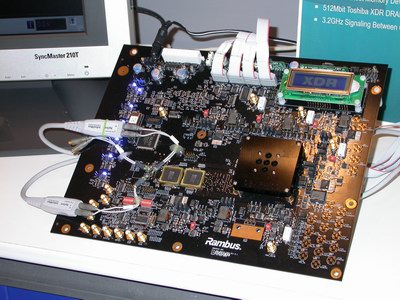Intel Developer Forum Spring 2004 - Day 1: Wider and Faster
by Derek Wilson on February 18, 2004 10:41 AM EST- Posted in
- Trade Shows
DDR, DDR2, RDRAM, and XDR
RAM technology continues to moving forward; many vendors were showing off their DDR2 memory at the Technology showcase, but we are going to save that coverage for later today.
We were able to speak with Samsung about what they are doing with DRAM at the moment. Samsung really has their bases covered making SDR, DDR, DDR2, 4 channel RDRAM and XDR. The upcoming XDR chips were on display up at the RAMBUS both across from a demo of Toshiba chips running at very high speeds (the bandwidth of XDR is 6.4GB/s).

4 Channel RDRAM will be supported by a SIS P4 chipset, and we are told to expect good things from P4 performance when dropped in a SIS system with 4 channel RDRAM. Hopefully we will be able to put the theories to the test sooner rather than later.










17 Comments
View All Comments
Mrburns2007 - Wednesday, February 18, 2004 - link
XDR has 6.4 GB/s per chip not module.Ecmaster76 - Wednesday, February 18, 2004 - link
"ultra emulated x86 with 8-way-hyperthreading and a +5 Dynamic Compiler of Doom"Sweet! Where can I get one? Is it compatible with my DRAM skin armor?
Someones been playing too much Baldur's Gate, and not just me.
(Think of all the processors Intel could sell with marketing like that.)
DerekWilson - Wednesday, February 18, 2004 - link
Actually, PCI-X is completely differet from PCI Express ... PCI-X is a parallel architecture that's wider and faster than the 32bit 33mhz pci bus ... PCI Express is specification for a point to point serial bus protocol (and multiple serial data streams can be sent to the same periphreial, thus the x16 pci express graphics card).Any when I was talking about ATI's "next gen" chip I wasn't talking about their current PCI Express solution RV380. I was talking about some unspecified demo that I'm going to assume was R420 or R423... I just didn't want to mention a card since ATI wouldn't tell me which card it was that was powering the box.
I think I fixed all the typos, sorry bout that ... I've been working by jumping between hotspots and hand coding html rather than using the dreamweaver over broadband that I'm used to ;-)
Lonyo - Wednesday, February 18, 2004 - link
Intel was pretty much always going to use compatible 64bit extensions.They have to work with the OS, since MS is pretty much dictating that.
AMD set up the initial spec (I would assume), and Intel didn't have much choice but to follow.
ATi and nVidia have to stick to the PCI-Express spec to make their next gen graphics cards, and that was designed by Intel, it's just a similar thing.
AMD obviously did well to get there first though and set the standards.
Malladine - Wednesday, February 18, 2004 - link
KillaKilla's older brother: PC3200 Bandwidth is 3.2gb/s :)http://www.kingston.com/newtech/ddrbandwidth.asp
KillaKilla - Wednesday, February 18, 2004 - link
whoops forgot a few things, guess I "jumped the gun[post]"...1st, this isn't KillaKilla, hes my brother, I don't have my own nick yet, sorry...
What did you mean by "2x to 3x performance gains" for native PCI-X (pci express is PCIX, right? I've seen it as PCI-E, but that was from before?) Also, what are these "HD streams"(2nd to last paragraph, 2nd page) you talk about?
3rd page:
"The upcoming XDR chips were on display up at the RAMBUS both across from a demo of Toshiba chips running at very high speeds (the bandwidth of XDR is 6.4GB/s)." Isn't DC-DDR 3200/400's bandwidth 6.4GB/s?
4th page:
I'm not surprised that intel cross-licenced x86-64... it was only logical seeing MS-XP64. Kudos to AMD for making a better 64-bit solution(extension set).
-KillaKilla's older brother
KillaKilla - Wednesday, February 18, 2004 - link
Once again, first post.Anyway, there are a few typos.
the Borad in the title?
The open tags on 2nd page